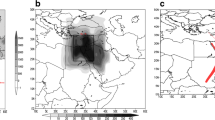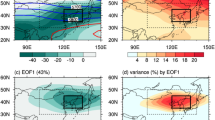Abstract
In this study, the Sudan low and the associated Red Sea trough (RST) are objectively identified using the mean sea level pressure (SLP) data from the National Center for Environmental Prediction/National Center for Atmospheric Research (NCEP/NCAR) reanalysis dataset covering the period 1955–2015. The Sudan low was detected in approximately 60.6% of the autumn periods, and approximately 83% of the detected low-pressure systems extended into RSTs, with most generated at night and during cold months. The distribution of the RSTs demonstrated that Sudan, South Sudan and Red Sea are the primary development areas of the RSTs, generating 97% of the RSTs in the study period. In addition, the outermost areas affected by RSTs, which include the southern, central and northern Red Sea areas, received approximately 91% of the RSTs originating from the primary generation areas. The synoptic features indicated that a Sudan low developed into an RST when the Sudan low deepened in the atmosphere, while the low pressures over the southern Arabian Peninsula are shallow and the anticyclonic systems are weakened over the northern Red Sea. Moreover, stabile areas over Africa and Arabian Peninsula form a high stability gradient around the Red Sea and the upper maximum winds weaken. The results of the case studies indicate that RSTs extend northward when the upper cyclonic and anticyclonic systems form a high geopotential gradient over Arabian Peninsula. Furthermore, the RST is oriented from the west to the east when the Azores high extends eastward and the Siberian high shrinks eastward or shifts northward.








Similar content being viewed by others
References
Alpert E, Neeman B, Shay-El Y (1990a) Climatological analysis of Mediterranean cyclones using ECMWF data. Tellus 42A:65–77
Alpert E, Neeman B, Shay-El Y (1990b) IntermonthIy variability of cyclone tracks in the Mediterranean. J Clim 3:1474–1478
Awad AM, Almazroui M (2016) Climatology of the winter Red Sea trough. Atmos Res 182:2016) 20–2016) 29. https://doi.org/10.1016/j.atmosres.2016.07.019
Almazroui M, Awad AM, Islam NM, Al-Khalaf AK (2015) A climatological study: wet season cyclone tracks in the East Mediterranean region. Theor Appl Climatol 120:351–365. https://doi.org/10.1007/s00704-014-1178-z
Almazroui M, Awad AM (2016) Synoptic regimes associated with the eastern Mediterranean wet season cyclone tracks. Atmos Res 180(2016):92–118. https://doi.org/10.1016/j.atmosres.2016.05.015
Broccoli AJ, Dahl KA, Stouffer RJ (2006) Response of the ITCZ to northern hemisphere cooling. Geophys Res Lett 33:L01702. https://doi.org/10.1029/2005GL024546
Barth HJ, Steinkohl F (2004) Origin of winter precipitation in the central coastal lowlands of Saudi Arabia. J Arid Environ 57:101–115
Bartholy J, Pongracz R, Pattantyus-Abraham M (2006) European cyclone track analysisbased on ECMWF ERA-40 data sets. Int J Climatol 26:1517–1527
Chakraborty A, Behera SK, Mujumdar M, Ohba R, Yamagata T (2006) Diagnosis of tropospheric moisture over Saudi Arabia and influences of IOD and ENSO. Mon Weather Rev 134:598–617
Dayan U, Sharon D (1981) Meteorological parameters for discrimination between widespread and spotty storms in the Negev, Israel. J Earth Sci 29:253–256
De Vries AJ, Tyrlis E, Edry D, Krichak SO, Steil B, Lelieveld J (2013) Extreme precipitation events in the Middle East: dynamics of the active Red Sea trough. J Geophys Res Atmos 118:7087–7108. https://doi.org/10.1002/jgrd.50569
De Vries AJ, Feldstein SB, Riemer M, Tyrlis E, Sprenger M, Baumgart M, Fnais M, Lelieveld J (2016) Dynamics of tropical–extratropical interactions and extreme precipitation events in Saudi Arabia in autumn, winter and spring. Q J R Meteorol Soc 142:1862–1880
El-Fandy MG (1948) The effect of Sudan monsoon low on the development of thundery conditions in Egypt, Palestine and Syria. Q J R Meteorol Soc 74:31–38
El-Fandy MG (1950) Effects of topography and other factors on the movement of lows in the Middle East and Sudan. Bull Am Meteorol Soc 10:375–381
Evans JP, Smith RB, Oglesby RJ (2004) Middle East climate simulation and dominant precipitation processes. Int J Climatol 24:1671–1694
Evans JP, Smith RB (2006) Water vapor transport and the production of precipitation in the eastern fertile crescent. J Hydrometeorol 7:1295–1307
Gates WL (1961) Static stability in the atmosphere. JMeteor 18:526–533
Haggag M, El-BadryH (2013) Mesoscale numerical study of quasi-stationary convective system over Jeddah in November 2009. Atmos Clim Sci 3(1):73–86. https://doi.org/10.4236/acs.2013.31010
Hannachi A, Awad A, Ammar K (2011) Climatology and classification of spring Saharan cyclone tracks. Clim Dynam 37:473–491. https://doi.org/10.1007/s00382-010-0941-9
Kahana R, Ziv B, Enzel Y, Dayan U (2002) Synoptic climatology of major floods in the Negev desert, Israel. Int J Climatol 22:867–882
Kalnay E, Kanamitsu M, Kistler R, Collins W, Deaven D, Gandin L, Iridell M, Saha S, White G, Woollen J, Zhu Y, Chelliah M, Ebisuzaki W, Higgins W, Janowiak J, Mo KC, Ropolewski C, Wang J, Leetma A, Reynolds R, Jenne R, Joseph D (1996) The NCEP/NCAR 40-year Reanalysis project. Bull Am MeteorolSoc 77:437–471
Kistler R, Collins W, Saha S, White G, Woollen J, Kalnay E, Chelliah M, Ebisuzaki W, Kanamitsu M, Kousky V, vandenDool H, Jenne R, Fiorino M (2001) The NCEP/NCAR 50-year Reanalyses: monthly CD-ROM and documentation. Bull Am MeteorolSoc 82:247–267
Krichak SO, Alpert P, Krishnamurti TN (1997a) Interaction of topography and tropospheric flow—a possible generator for the Red Sea trough? Meteorog Atmos Phys 63:149–158
Krichak SO, Alpert P, Krishnamurti TN (1997b) Red Sea Trough/cyclone development—numerical investigation. Meteorol Atmos Phys 63:159–169
Krichak SO, Alpert P (1998) Role of large scale moist dynamics in November 1–5, 1994 hazardous Mediterranean weather. J Geophys Res, 103 453–19(458):19
Krichak SO, Tsidulko M, Alpert P (2000) November 2, 1994, severe storms in the southeastern Mediterranean. Atmos Res 53:45–62
Krichak SO, Breitgand JS, Feldstein SB (2012) A conceptual model for the identification of active Red Sea trough synoptic events over the southeastern Mediterranean. J Appl Meteor Climatol 51:962–971. https://doi.org/10.1175/JAMC-D-11-0223.1
Krichak SO, Barkan J, Breitgand JS, Gualdi S, Feldstein SB (2015) The role of the export of tropical moisture into midlatitudes for extreme precipitation events in the Mediterranean region. Theor Appl Climatol 121(3–4):499–515. https://doi.org/10.1007/s00704-014-1244-6
Kumar KN, Entekhabi D, Molini A (2015) Hydrological extremes in hyperarid regions: a diagnostic characterization of intense precipitation over the central Arabian peninsula. J Geophys Res Atmos 120:1637–1650. https://doi.org/10.1002/2014JD022341
Nazemosadat MJ, Ghaedamini H (2010) On the relationships between the madden–Julian oscillation and precipitation variability in southern Iran and the Arabian peninsula: atmospheric circulation analysis. J Clim 23:887–904
Raziei T, Mofidi A, Santos AJ, Bordi I (2012) Spatial patterns and regimes of daily precipitation in Iran in relation to large-scale atmospheric circulation. Int J Climatol 32:1226–1237
Schneider T, Bischoff T, Haug GH (2014) Migrations and dynamics of the intertropical convergence zone. Nature 513:45–53
Tsvieli Y, Zangvil A (2005) Synoptic climatological analysis of “wet” and “dry” Red Sea troughs over Israel. Int J Climatol 25:1997–2015. https://doi.org/10.1002/joc.1232
Tsvieli Y, Zangvil A (2007) Synoptic climatological analysis of Red Sea trough and non-Red Sea trough rain situations over Israel. Advances in Geosciences, European Geosciences Union 12:137–143
Viswanadhapalli Y, Dasari HP, Langodan S, Challa VS, Hoteit I (2016) Climatic features of the Red Sea from a regional assimilative model. Int J Climatol:1–19
Ziv B, Dayan U, Sharon D (2005) A mid-winter, tropical extreme flood-producing storm in southern Israel: synoptic scale analysis. Meteorol Atmos Phys 88:53–63
Acknowledgments
The authors are grateful to King Abdulaziz University for providing the facilities and logistical support for this study. The authors also acknowledge NASA and NCEP/NCAR for providing the meteorology data through their websites.
Author information
Authors and Affiliations
Corresponding author
Rights and permissions
About this article
Cite this article
Awad, A.M., Mashat, AW.S. Climatology of the autumn Red Sea trough. Theor Appl Climatol 135, 1545–1558 (2019). https://doi.org/10.1007/s00704-018-2453-1
Received:
Accepted:
Published:
Issue Date:
DOI: https://doi.org/10.1007/s00704-018-2453-1




